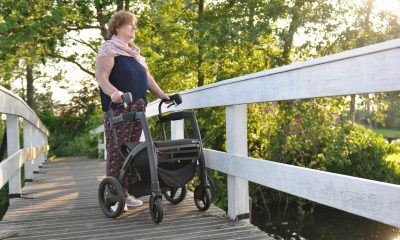Biotech
Health Finances the First Subcutaneous Infusion Treatment Based on Levodopa for Advanced Parkinson’s
The approval of the treatment is based on two pivotal phase III clinical trials: M15-741 and M-15-736. Primary endpoint results from the first trial showed that adverse events were mostly non-serious and mild/moderate in severity. Secondary endpoint results at week 52 showed improvements in “ON” time without disabling dyskinesia (3.8 ± 3.3 · 3.3 hours) and improvements in “OFF” time relative to initial hours (-3.5 ± 3.1]).

The Ministry of Health has announced the financing of the first continuous subcutaneous infusion treatment based on levodopa (foslevodopa, FLD / foscarbidopa, FCD) for the treatment of advanced Parkinson’s. Marketed as Duodopa, this solution is indicated in patients who respond to levodopa, with severe motor fluctuations and hyperkinesia or dyskinesia when the combinations of medications available for Parkinson’s have not provided satisfactory results.
“This new treatment represents a significant advance in the approach to Parkinson’s disease, as it offers a new non-surgical levodopa-based subcutaneous treatment option that can help control motor symptoms for those living with advanced Parkinson’s disease who sometimes “They often experience challenges as their disease progresses ,” explains Dr. Álvaro Sánchez-Ferro , coordinator of the Movement Disorders Study Group of the Spanish Society of Neurology (SEN), during a press conference organized by the pharmaceutical company Abbvie. , which develops and produces this therapy.
With the financing of this treatment, patients no longer need to undergo surgery for the administration of foslevodopa and foscarbidopa. Instead, the cse patient is implanted with a subcutaneous infusion system for continuous administration over 24 hours. This innovation already represents an improvement in the patient’s quality of life.
Read more about the new treatment for Parkinson’s disease and find the latest financial news of the day with our companion app Born2Invest.
This levodopa-based treatment has proven effective in reducing the most common symptoms of Parkinson’s disease
The treatment has proven effective in reducing the most common symptoms of Parkinson’s disease. Motor symptoms include tremor at rest, bradykinesia, muscle rigidity or balance and posture problems. As for non-motor problems, sleep problems have a prevalence of between 42% and 98%. Other problems may also occur such as depression, anxiety, fatigue or muscle pain. “The symptoms of the disease are often talked about in terms of ON and OFF time. The ON time occurs when the symptoms are controlled and the OFF time is when the symptoms return between doses of the medication ,” adds Dr. Rocío García-Ramos , neurologist at the San Carlos Clinical Hospital in Madrid.
The approval of the treatment is based on two pivotal phase III clinical trials: M15-741 and M-15-736. Primary endpoint results from the first trial showed that adverse events were mostly non-serious and mild/moderate in severity. Secondary endpoint results at week 52 showed improvements in “ON” time without disabling dyskinesia (3.8 ± 3.3 · 3.3 hours) and improvements in “OFF” time relative to initial hours (-3.5 ± 3.1]). For its part, the second trial demonstrated that patients treated with Duodopa showed significant improvements in “ON” time.
__
(Featured image by National Cancer Institute via Unsplash)
DISCLAIMER: This article was written by a third party contributor and does not reflect the opinion of Born2Invest, its management, staff or its associates. Please review our disclaimer for more information.
This article may include forward-looking statements. These forward-looking statements generally are identified by the words “believe,” “project,” “estimate,” “become,” “plan,” “will,” and similar expressions. These forward-looking statements involve known and unknown risks as well as uncertainties, including those discussed in the following cautionary statements and elsewhere in this article and on this site. Although the Company may believe that its expectations are based on reasonable assumptions, the actual results that the Company may achieve may differ materially from any forward-looking statements, which reflect the opinions of the management of the Company only as of the date hereof. Additionally, please make sure to read these important disclosures.
First published in iSanidad. A third-party contributor translated and adapted the article from the original. In case of discrepancy, the original will prevail.
Although we made reasonable efforts to provide accurate translations, some parts may be incorrect. Born2Invest assumes no responsibility for errors, omissions or ambiguities in the translations provided on this website. Any person or entity relying on translated content does so at their own risk. Born2Invest is not responsible for losses caused by such reliance on the accuracy or reliability of translated information. If you wish to report an error or inaccuracy in the translation, we encourage you to contact us

-

 Biotech2 weeks ago
Biotech2 weeks agoSpain Prioritizes Clinical Benefit Over Efficiency in Funding New Cancer Drugs
-

 Biotech3 days ago
Biotech3 days agoAsebio Welcomes the EU Biotech Act as a Boost to Competitiveness and Health Autonomy
-

 Africa1 week ago
Africa1 week agoBank Al-Maghrib’s Final 2025 Meeting Expected to Maintain Key Interest Rate
-

 Africa6 days ago
Africa6 days agoMorocco Allocates 1.3 Billion Dirhams to Boost Startup Ecosystem Under Digital 2030 Strategy



















